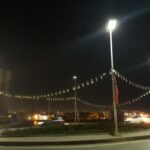All solar street lights come from an idea. For you to share the ideas, you must put them in the form of a drawing. The solar street light drawing can then be used in the design of the equipment and acts as the plan for the final product.
In most cases, the first drawing of the product is not necessarily the image of the final product: more modification would be required based on factors such as the availability of resource material and equipment.
Designers and engineers from all over the world use drawings and pictures to communicate with each other. Therefore, you’ll need a technical guideline for your solar street light drawing for you to create a good first impression and communicate clearly in a language that most people in the industry understand.
You will need to include drawings on documents such as design proposals, technical specifications, and product assembly in the manual. For a better understanding of the technical requirements for the solar street light, you will need to include drawings in documents such as brochures, catalogs, manuals, and tenders.
Types of Drawings
- Freehand or gestural drawings
A sketch comes from the raw data in your mind. It is the first step in drawing a solar start light and creates a hint of the design of the complete product. This type of drawing does not represent the final product, so you can modify it if you want.
You will need this drawing to gets your idea to the paper. Drawing instruments are not required; they are usually done using your hand, paper, and pencil.
- Illustration Drawing
This type of drawing is created to represent the layout of a solar street light. It can be used to demonstrate the flow of electricity from the solar modules, through the battery and into the lighting fixture to produce light. According to electrical drawing standards, illustrative drawing can easily be used to show the circuitry of an entire system.
- Geometric Drawing
You will require a geometric drawing for dimensional purposes. It will require some descriptive views and measured scales of the various components. Space, distance and volume can be represented using a Perspective drawing: 2D or 3D drawings.
- Technical drawing
Most manufacturers use engineering drawings to define the requirements for engineering a solar street light. Technical drawings vary depending on your projection needs. Either an isometric or Orthographic drawing can represent the objects, depending on the views you need two, three, or four views.
An isometric drawing can show overall appearance an assembled component, but not necessarily the details and the dimensions.
Dimensioning
You will need to add dimensions to your technical drawing. It should be done in the most useful way and should contain as many dimensions as possible to assist in the design and production of the component. You need to identify redundant dimensions and avoid using them because they may clutter the drawing.
In dimension, you should use accurate values and appropriate position them without duplicating them. Also, you should use the appropriate line quality for legibility.
In terms of drawing or drafting, there are two types of standards: ANSI and international standard (ISO) dimensions. Globalization demands that you use internationally recognized measurements such as the International System of Units (SI), the new metric system and the imperial or British system.
Sectioning
Another feature to use in a technical drawing is sectioning. This technique allows the craftsman or user to see what’s inside the component or unit. You can use sectioning in solar street light drawings to show the intricate details of the various components.
You can use sectioning to show hidden components in the various solar street light components. It can only work in components that have cross-sectional projections. This type of drawing will help explain how the intricate parts of any component.
Tools for Drawing
- Freehand
You can achieve clear views of your components using freehand if you have an artist in your team. Drawing by hand takes less time, and it is used in decision making and transferring ideas on paper. Sketches can be drawn by hand and are not very technical since they represent an idea.
- Manual Drafting Instruments
Software used for drawing can be quite expensive to own, so the least expensive tool most designers and engineers go for is the use of manual drafting instruments. Manual drafting instruments help the designer measure, draw straight lines and create angles. They include rulers, protractors, drafting Compasses and curves, and a flat drafting table.
- Software
When it comes to drawing a clear representation of the final product, you may use a professional designer to do it by hand, but many opt to use the software. There are many computer-aided drafting or design, or CAD software available to help you draw.
A CAD software can help you capture all angles, precisions, and crucial details that may be hard or time-consuming using other tools. It may also give you an exploded view of the street light system, an important diagram in the assembly and disassembly of any equipment.
The advantage of using CAD is that you can add texture, color, and other features such as welding joints to your drawings. Drawing with software allows you to add observable characteristics of the product to the drawing.
Drawing standards
The basic drawing standards and conventions are the same everywhere. For better communication, you need to use common architectural, engineering or industrial design standards. Your target market and compliance with international quality will define the standards. To promote trade, you’ll have to use internationally recognized standards.
Solar Street Light Drawing: Drawing details
A solar street light drawing should capture dimensional and design information of the :
- System
- Components,
- Columns,
- Arms & brackets,
- Footings
- Wiring, and Cabling
A technical guideline for the solar street light drawing will assist you in the production, installation, wiring, and replacement of faulty components. Using drawing as a technique for describing a product is more effective than a technical narrative and saves time and any confusion caused by the use of jargon or technical words.
















